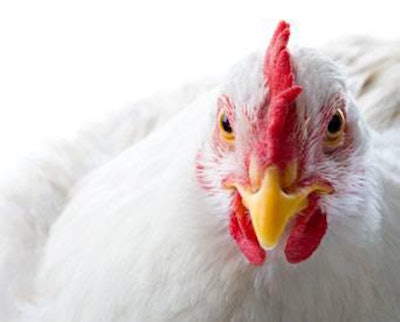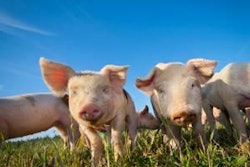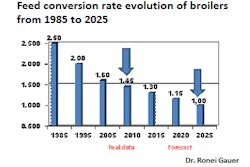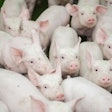
During the production cycle of a broiler, many factors influence a bird’s ability to achieve the full metabolizable energy (ME) potential of the feed. Changes in diet and environment — as well as its genetics — can play a role. However, poultry producers’ main challenge is the variance in feed digestibility and its impact on animal productivity.
Producers must continue to meet performance objectives, in terms of both growth and flock uniformity, despite increases and volatility in raw material costs (see Figure 1). This challenge has seen an increase in the use of alternative ingredients and byproducts in poultry feed such as DDGS, rice bran, rapeseed meal, canola meal, sunflower meal, palm kernel meal and wheat pollard.
Inclusion of these alternative raw materials in feed formulations introduced a complete set of challenges: maintaining the nutrient specification of the diet and managing anti-nutrient factors. Compared to more traditional feed ingredients, the challenges of these materials are highlighted by their composition as they tend to be lower in both starch and protein quality and have higher levels of anti-nutrient factors, e.g. arabinoxylans and phytate.
Problems with anti-nutrients
Insoluble arabinoxylans are structural components of the cell walls of plant that are poorly digested by monogastric animals. Increased levels insoluble arabinoxylans produce a barrier for endogenous enzyme activity on storage proteins, starch and fat. They have also been associated with increased digesta viscosity, slower transit time, lower nutrient digestibility and undesirable shifts in gut microbiota. The combined effects of these characteristics negatively impact animal performance and gut health.
Phytate is another potent anti-nutrient. It binds minerals, starch and proteins, increasing their resistance to digestion. This can lead to increased ileal amino acid flow which, in turn, provides substrates that can encourage pathogen growth.
Failing to hydrolyse phytate also carries an environmental burden as it leads to a greater threat of phosphorous pollution and higher manure management and legislative compliance costs. To exemplify the extent of the challenge, roughly 45 percent of all phosphorous consumed in the normal diet of a 42-day-old broiler is excreted in manure. If we consider that the United States alone produces 60 million broiler breeders and 9 billion broilers every year, the cumulative phosphorus excretion reaches a staggering 115,000 metric tons/year. The environmental impact of reducing phosphorous for for U.S. broilers is considerable.
Dealing with variations
Cultivation methods and harvest conditions can produce varying feed substrate levels, which in turn lead to similar digestibility, performance and environmental issues. Corn, for example, is the most common feed grain used globally, but its feed value is universally recognized as being variable — sometimes just as variable as viscous grains such as wheat.
Moving from simple corn-soy based diets to more complex ones, which include a variety of alternative raw materials to reduce feed costs, has a significant effect on the dietary substrates available for digestion by the animal. For example, the inclusion of a wider variety of protein and energy sources produces a corresponding increase in fiber (NDF, ADF and arabinoxylans) and phytate levels and decreases in starch in the diet (see Figure 2). Digestible amino acids, expressed as a proportion of total amino acids in the diet, also decreases. This combination of effects creates unique nutritional challenges that need to be overcome in order for animal performance to be maintained while reducing costs per kg gain.
The solution lies with enzymes
Exogenous enzymes have traditionally offered value in relatively simple diets. They improve animal performance and uniformity by increasing nutrient digestibility while counteracting variability in raw materials. As diets become increasingly complex and the quality more variable, it is generally acknowledged that enzyme usage becomes even more valuable.
Phytase offers a relatively cheap, affordable way to eliminate the anti-nutritive effect of phytate and maximize its digestibility, which also improves animal welfare by reducing the risk of skeletal problems. The latest Buttiauxella-based phytase offers additional benefits over E. Coli equivalents, including: much higher activity earlier in the digestive tract, minimization of the anti-nutrient effects of phytate and maximization of the time available for nutrient digestion and absorption. An added benefit of using both traditional and new generation phytases is their ability to reduce phosphorus in manure.
Enzyme, phytase combination produce benefits
The combination of carbohydrase enzymes with the right amount of phytase can also radically improve complex diet performance and slash overall production costs.
If we look, for example, at combining xylanase, amylase and protease enzymes on top of phytase, the results are dramatic:
- Xylanase (X) breaks down the non-starch polysaccharides (NSPs) such as soluble and insoluble arabinoxylans in the feed reducing digesta viscosity in viscous grains such as wheat and releasing previously trapped nutrients.
- Amylase (A) increases the hydrolysis of starch improving its digestibility, and complements the secretion of endogenous amylases.
- Protease increases protein digestibility by hydrolysis of storage and structural proteins, and disrupts interactions of proteins with starch and fiber in the diet. Additionally, it targets other anti-nutritional factors in the diet, e.g. residual trypsin inhibitors and lectins in soybean meal and some other vegetable proteins. Using this combination with a standard dose of Buttiauxella-based phytase, producers can achieve consistent feed quality and body weight/calorie conversion improvements to save between $80,000 to $100,000 per million birds.
Observing how exogenous enzyme combinations (e.g. xylanase, amylase and protease) and other feed additives interact with the new generation of bio-efficacious phytases will be important to ensure that performance and cost benefits are delivered despite volatile market conditions. References on request from [email protected].

















